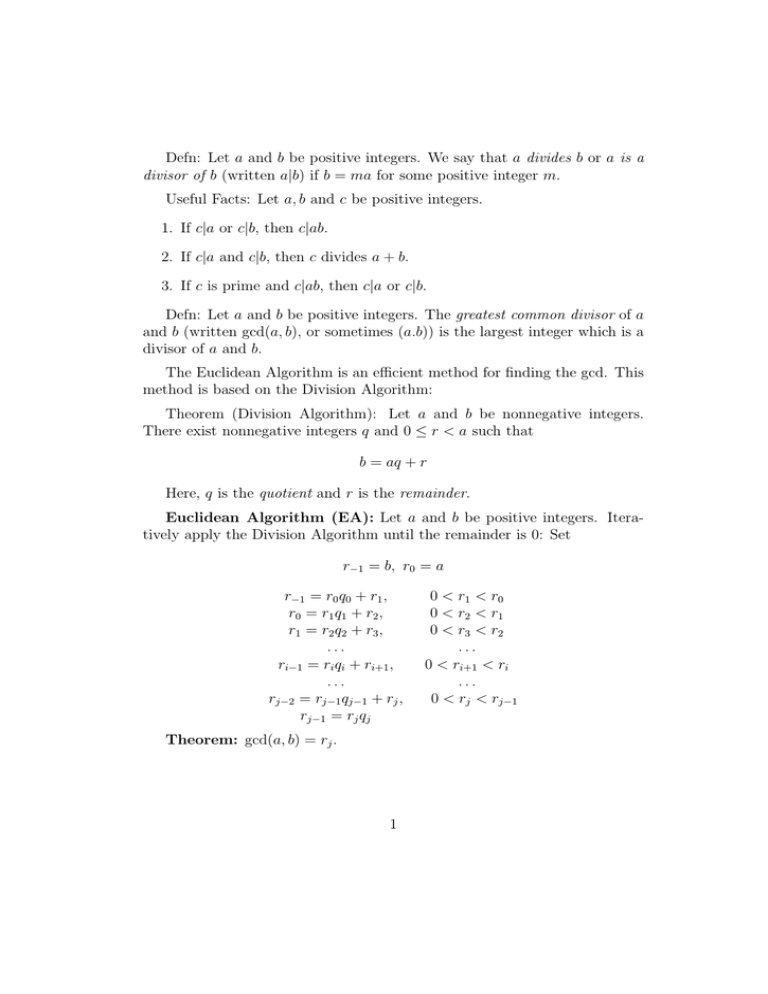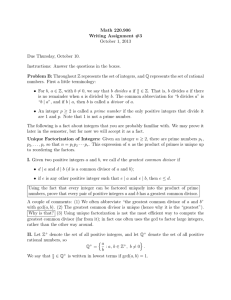Defn: Let a and b be positive integers. We say... divisor of b (written a|b) if b = ma for...
advertisement

Defn: Let a and b be positive integers. We say that a divides b or a is a divisor of b (written a|b) if b = ma for some positive integer m. Useful Facts: Let a, b and c be positive integers. 1. If c|a or c|b, then c|ab. 2. If c|a and c|b, then c divides a + b. 3. If c is prime and c|ab, then c|a or c|b. Defn: Let a and b be positive integers. The greatest common divisor of a and b (written gcd(a, b), or sometimes (a.b)) is the largest integer which is a divisor of a and b. The Euclidean Algorithm is an efficient method for finding the gcd. This method is based on the Division Algorithm: Theorem (Division Algorithm): Let a and b be nonnegative integers. There exist nonnegative integers q and 0 ≤ r < a such that b = aq + r Here, q is the quotient and r is the remainder. Euclidean Algorithm (EA): Let a and b be positive integers. Iteratively apply the Division Algorithm until the remainder is 0: Set r−1 = b, r0 = a r−1 = r0 q0 + r1 , r0 = r1 q1 + r2 , r1 = r2 q2 + r3 , ... ri−1 = ri qi + ri+1 , ... rj−2 = rj−1 qj−1 + rj , rj−1 = rj qj Theorem: gcd(a, b) = rj . 1 0 < r1 < r0 0 < r2 < r1 0 < r3 < r2 ... 0 < ri+1 < ri ... 0 < rj < rj−1 Example: Let a = 657 and b = 963. 963 657 306 45 36 = = = = = 657 · 1 + 306 306 · 2 + 45 45 · 6 + 36 36 · 1 + 9 9·4 Thus, gcd(657, 963) = 9. Proof of Theorem: Let d be a common divisor of a and b. We will first show, by induction, that d is a common divisor of ri−1 and ri for all i = 0, . . . , j. The base case, i = 0, is true by assumption. For the inductive step, observe that since ri−2 = ri−1 qi−1 + ri , if d is a common divisor of ri−2 and ri−1 then it is a divisor of ri and thus a common divisor of ri−1 and ri . This completes the induction. In particular, d divides rj , and so rj is at least as large as any common divisor of a and b. It remains only to show that rj itself is a common divisor of a and b. From the last equation, we see that rj divides rj−1 , and so rj is a common divisor of itself and rj−1 . Then, from the next-to-last equation, we see that rj divides rj−2 , and so rj is a common divisor of rj−2 and rj−1 . Now run backwards through the steps of the Euclidean Algorithm, to see, by induction, that for i = j, . . . , 0, rj is a common divisor of ri and ri−1 . In particular, rj divides r0 = a and r−1 = b, as desired. Bezout’s Identity: Let a and b be positive integers and let g = (a, b). Then there exist integers m, n (not necessarily positive) such that am + bn = gcd(a, b) We can use the Euclidean Algorithm to not only prove Bezout’s Identity, but to explicitly find a m and n. The idea is to run backwards through the Euclidean Algorithm. As an example, we work through the Example above. 2 9 = = = = = = = = 45 − 36 45 − (306 − 45 · 6) −306 + 45 · 7 −306 + (657 − 306 · 2) · 7 657 · 7 − 306 · 15 657 · 7 − (963 − 657) · 15 −963 · 15 + 657 · 22 657 · 22 − 963 · 15 So, m = 22 and n = −15. To see that this always works, we show: Proposition: For each i = j − 1, . . . , 0, there are integers mi and ni such that ri mi + ri−1 ni = rj (1) Note that the case i = 0 yields Bezout’s identity. We prove the Proposition by induction. For the base case, i = j − 1, set mi = −qj−1 and ni = 1. For the inductive step, note that since ri−2 = ri−1 qi−1 + ri , we have ri = ri−2 − ri−1 qi−1 . Substitute this expression for ri into (1) to obtain rj = ri mi + ri−1 ni = (ri−2 − ri−1 qi−1 )mi + ri−1 ni = ri−1 (ni − qi−1 mi ) + ri−2 mi which we write as ri−1 mi−1 + ri−2 ni−1 Thus, (1) holds for all i. Note that the m and n in Bezout’s Identity are by no means unique. For example, let a = 2 and b = 3, with gcd = 1. Then 1 = 2·(−1)+3·1 = 2·2−3·1. Finally, we apply EA and Bezout to find inverses in Zq when q is prime. First, observe that if q is prime and a ∈ Zq and a 6= 0 mod q, then gcd(a, q) = 1. By Bezout, there exist integers m, n such that am+qn = 1. Thus, am = 1 mod q, and so a−1 = m mod q. Use EA and Bezout to explicitly find m. 3





